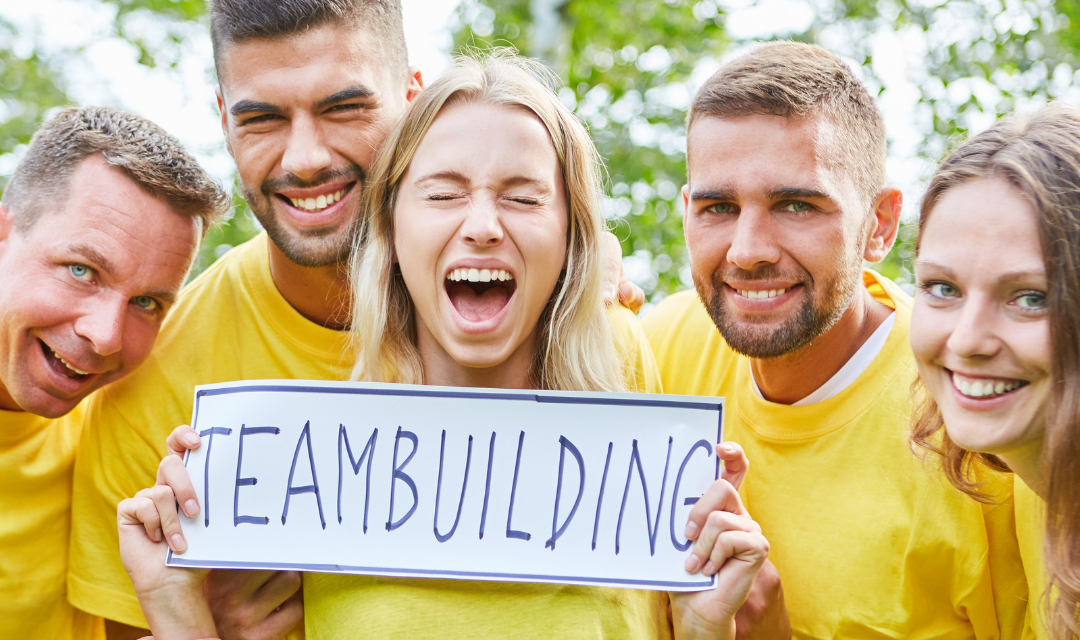Good team dynamics are essential for the success of any organization. When team members have strong relationships with each other, they are more likely to collaborate effectively and produce better results. Despite its importance, team dynamics aren’t always easy to foster. That’s why many organizations turn to team-building events as a way to improve working relationships among their teams.
Team-building events can range from casual lunches to complex problem-solving activities that require cooperation and collaboration. These events can be used in different ways depending on the particular needs of a team or organization. In this article, we’ll discuss some innovative ways to use team-building events to improve team dynamics.
We’ll look at how you can use individual and group activities, virtual and remote events, outdoor exercises, and games to encourage colleagues to play together, get out of their comfort zones, and foster better teamwork. We’ll also examine how these activities can help build trust among coworkers and form stronger bonds between them. Once you’ve read this article, you’ll have a better understanding of how to use team-building events to improve your overall team dynamics. Let’s dive in!
What are TeamBuilding Events?
Team-building events are a great way to improve team dynamics and create a more cohesive and productive team. Such events can include activities like icebreakers, team competitions, or games designed to build trust, communication, collaboration, and problem solving skills among the team members.
Team building events can come in many forms, but they all have one main goal: to create an environment where team members are more comfortable interacting with each other, better understand their roles within the group, and ultimately learn how to work together more effectively.
In this article, we’ll explore some innovative ways to use team-building events to improve team dynamics. We’ll look at different types of team-building events like icebreakers and games, as well as discuss what makes a successful event for your particular group. We’ll also look at how you can measure the success of your team-building event and develop strategies for planning future events. By the end of this article, you will have the knowledge needed to plan and execute successful team-building events that will help foster strong relationships between your colleagues.
Why Are TeamBuilding Events Important?
Team-building events are important for a number of reasons. First, they help team members get to know one another and build relationships. This is especially important in teams that are newly formed or have members that are not well acquainted with one another. Strong relationships are key to a high-performing team, as they help members trust and rely on one another.
Second, team-building events can help to improve communication and collaboration within a team. Often, teams that struggle with communication or collaboration do so because members are not clear on each other’s roles and responsibilities. By taking part in team-building activities, members can learn more about one another’s strengths and weaknesses and how they can best work together.
Finally, team-building events can boost morale and motivation within a team. When team members feel like they are part of a supportive and cohesive unit, they are more likely to be motivated to do their best work. Team-building activities can help create this feeling by giving members a chance to have fun and bond with one another.
How to Improve Team Dynamics Through TeamBuilding Events
One of the best ways to improve team dynamics and communication is to hold team-building events. These events can be used to build relationships, trust, and cooperation within a team. There are a variety of team-building activities that can be used to improve team dynamics. Some popular team-building activities include:
1. Physical activities: Physical activities are a great way to get team members to interact with each other and build relationships. Activities such as paintball, laser tag, and hiking can help team members bond with each other and build trust.
2. Communication exercises: Communication exercises are designed to help team members learn how to communicate effectively with each other. These exercises can be used to improve problem-solving skills and collaboration.
3. Ropes courses: Ropes courses are another great way to get team members to interact with each other and build trust. Ropes courses can also help team members overcome fears and learn to work together.
4. Scavenger hunts: Scavenger hunts are a fun way for team members to work together to find items or complete tasks. This activity can help team members learn to communicate and work together effectively.
5. Trust exercises: Trust exercises are designed to help team members build trust with each other. These exercises can be used to improve communication and collaboration within a team.

Tips for Hosting Successful TeamBuilding Events
When it comes to hosting successful team-building events, there are a few key things to keep in mind. First and foremost, it’s important to choose an activity that will appeal to the majority of your team members. There’s no use in choosing an activity that only a handful of people will enjoy – you want everyone to be able to get something out of the event.
Another important consideration is to ensure that the activity you choose is challenging yet achievable. It should push your team members out of their comfort zones but not be so difficult that it’s impossible to complete. A good team-building event should leave your team feeling satisfied and proud of their accomplishments.
Finally, make sure to debrief after the event. This is a crucial step in ensuring that your team-building event was successful. Take some time to talk about what went well and what could be improved upon. This will help to ensure that your next team-building event is even more successful than the last!
Ideas for TeamBuilding Activities
There are a number of different types of team-building activities that can be beneficial for improving team dynamics. Some examples include:
1. Communication Activities: These types of activities help team members learn to communicate more effectively with each other. They can involve role-playing exercises, problem-solving tasks, or simply open and honest discussions about the team’s goals and how everyone can best work together to achieve them.
2. Trust Activities: These activities help team members learn to trust and rely on each other. They can involve blindfolded trust walks, trust falls, or other exercises that require team members to put their faith in each other.
3. Creativity Activities: These activities help team members tap into their creative side and come up with new ideas. They can involve brainstorming sessions, arts and crafts projects, or anything else that gets team members thinking outside the box.
4. Physical Activities: These activities help team members bond with each other and get some physical exercise at the same time. They can involve group sports, hiking, or any other type of activity that gets everyone moving and working together.
5. Fun Activities: These activities help team members relax and have fun together. They can involve games, movie nights, or anything else that the team enjoys doing together.
6. Service Projects: These types of activities help team members feel good about giving back to the community. They can involve volunteering at a local charity, organizing a food drive, or anything else that helps those in need.
Team building activities ideas for remote teams
When people think of team-building activities, they often envision group outings or exercises that require participants to be in close physical proximity to one another. However, with the rise of remote workforces, team-building activities have had to adapt to the new reality of dispersed teams. Here are some ideas for team-building activities that can be done remotely, to help improve team dynamics and communication:
1. Virtual happy hours or coffee breaks: Get the team together for a virtual happy hour or coffee break using video conferencing software like Zoom or Google Hangouts. This is a great way to catch up with colleagues and build relationships in a relaxed setting.
2. Remote scavenger hunts: A remote scavenger hunt is a great way to get team members working together to solve puzzles and complete challenges. You can create your own hunt, or use an online service like Scavenger.
3. Online trivia or game nights: trivia nights and online games are fun ways to encourage friendly competition and bonding among team members. There are lots of online games that can be played for free, such as QuizUp and Cahoot!.
4. Virtual book clubs: Reading is a great way to learn about new topics and expand your worldview. Start a virtual book club with your team where everyone reads the same book and then discusses it together. Goodreads has a list of popular book club picks.
5. Remote cooking or baking contests: A cooking or baking contest is a fun way to get the team working together on a creative project. You can use an online service like CookSmarts to organize the contest and provide recipes and ingredient lists to participants.
Benefits of TeamBuilding Events
It has been proven time and again that team building events have a plethora of benefits for both employees and employers. For employees, team building activities can help improve morale, foster a sense of camaraderie and teamwork, and boost job satisfaction. For employers, team building can improve communication and productivity, while also reducing workplace stress. In fact, some studies have shown that team building events can lead to a ROI of up to 800%!
When it comes to benefits, there are few things that can compare to team building activities. Here are 5 benefits of team building events that you should know about:
1. Improved Communication
One of the most important benefits of team building is improved communication. In order to work together effectively, teams need to be able to communicate clearly and efficiently. Team building activities can help employees learn how to communicate better with one another. This is because team building exercises often require employees to work together to solve problems or complete tasks. As such, they need to be able to communicate clearly in order to complete the task at hand.
2. Boosted Morale
Another great benefit of team building is that it can help boost employee morale. When employees feel like they are part of a team and are working together towards a common goal, they are more likely to feel motivated and engaged in their work. Team building activities can help create this sense of camaraderie and teamwork among employees.
3. Improved Productivity
Improved communication and morale often lead to one thing: improved productivity. When employees are able to communicate better with one another and feel like they are part of a team, they will be more likely to be productive at work. This is because they will feel more invested in their work and will be less likely to waste time on things that are not related to their job.
4. Reduced Stress
Team building activities can also help reduce workplace stress. This is because when employees feel like they are part of a team and are working together towards a common goal, they will feel less stressed about their individual jobs. Additionally, team building can help reduce stress by providing an outlet for employees to blow off some steam and have fun outside of work.
5. Improved Job Satisfaction
Finally, team building can lead to improved job satisfaction. When employees feel like they are part of a team and are working towards a common goal, they will be more likely to enjoy their job. Additionally, when employees feel like their voices are being heard and that their opinions matter, they will be more likely to be satisfied with their job overall.
Considerations When Planning a TeamBuilding Event
When it comes to planning team-building events, there are a few key considerations to keep in mind. First, you’ll want to consider the size of your team and the budget you have to work with. You’ll also want to think about the type of event that would be most beneficial for your team. For example, if you’re trying to improve communication within your team, you might want to consider a scavenger hunt or an escape room. If you’re trying to promote teamwork and collaboration, you might want to consider a cooking class or a ropes course.
Once you’ve considered these factors, you’ll also want to start thinking about logistics. Where will the event be held? What type of food and drink will be served? How will you get everyone to and from the event? These are all important details to iron out before you can start planning your team-building event.
Tips for Creating an Inclusive Environment During TeamBuilding Events
When planning team-building events, it’s important to create an inclusive environment for all attendees. Here are eight tips to help you do just that:
- Plan activities that everyone can participate in.
- Make sure the venue is accessible for all attendees.
- Choose activities that appeal to a variety of interests and skill levels.
- Allow attendees to opt out of certain activities if they’re not comfortable with them.
- Make sure there are plenty of breaks throughout the event.
- Encourage attendees to mingle and get to know one another.
- Avoid controversial topics that could cause arguments or hurt feelings.
- Be prepared to deal with any problems that arise during the event.
- Common Pitfalls to Avoid When Planning TeamBuilding Events
When it comes to team building, there are a few common pitfalls that organizations often fall into. These can include:
1. Not Defining the Objective: One of the most common mistakes is not having a clear objective for the team-building event. What is the purpose of the event? What do you want to achieve? Without a clear objective, it can be difficult to measure the success of the event and determine whether it was worth the investment.
2. Not Knowing Your Audience: It’s important to have a good understanding of your team before planning any kind of team-building activity. What kind of activities will they enjoy? What will they find motivating? What will bring out the best in them? If you don’t know your audience, it’s likely that the event will not be as successful as it could be.
3. Not Considering Budget: Team-building events can be expensive, so it’s important to consider budget when planning. There are often ways to save money by planning ahead or being creative with the activities, but if you don’t consider your budget from the outset, you could end up spending more than you intended.
4. Overdoing It: When it comes to team building, sometimes less is more. If you try to pack too much into one event, it can actually have the opposite effect and cause stress and anxiety among team members. It’s important to find a balance and focus on quality over quantity.
5. Forgetting to Follow-Up: The team-building event is just one part of improving team dynamics – it’s important not to forget about follow-up. There should be a plan for how team members will continue to work together effectively after the event is over. Otherwise, all your hard work (and money) could be for nothing.
Conclusion
Team-building events are a great way to improve team dynamics and create an inclusive environment. By taking into consideration the different types of activities that are best suited for the team, hosting a successful event, and avoiding common pitfalls, team-building events can be an effective tool for improving team dynamics. With the help of innovative ideas such as virtual team building activities and remote team building activities, organizations can now also use these events to build relationships among their remote teams. Team-building events can be a great opportunity to strengthen relationships, foster collaboration, and develop a strong sense of community among your team.





